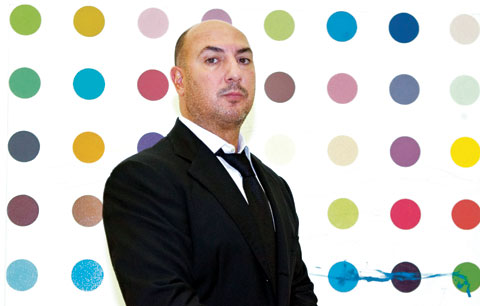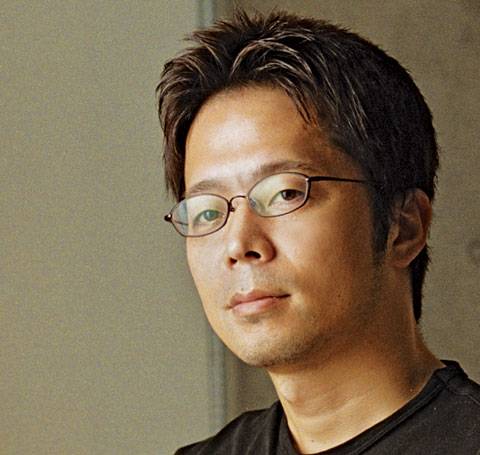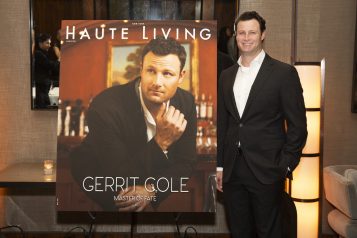Gary Nader, curator, consultant, appraiser, auctioneer, and publisher, has helped elevate Miami’s status in the elite art world, allowing the city to be worthy of the international attention it garners.
By Jeremy Lissek
Photography by Reynaldo Alés
“If you buy an artist that has been consistent, that has a curriculum, that is respected by the art critics, you’re making a sound investment.”
It is quiet in here. Out there, a sun-drenched Friday afternoon in Miami is ramping up with typical brusque buzz, it’s rush hour and happy hour and early bird hour converging to create a perfect storm of chaos. But in here, it’s quiet; an open-floor, spacious oasis of white walls alive with color and form. And over there, the floor sprouts jagged, sensually angled and folded pink Portuguese marble and roly-poly bronze men, ballerinas, birds, and horses. I rang the buzzer and somebody let me in, but he’s vanished. It’s hard not to vanish here. I’m alone and lost in a 10-foot, multi-colored Lichtenstein totem-sculpture when someone in black and white emerges from one of the vanishing points and darts past me with a “whoosh.” He doesn’t interrupt my serenity. He seems to be fully focused within his own trance; he’s moving rapidly, with purpose, for the other side of this hangar-long room until he’s gone again. I get the sense I should follow him.
I find him, already busy, in an office. A typical office, if your idea of a typical office is one furnished with several couches and a head-spinning haul of masterpieces. There’s a Miro and a Matisse and a few Picasso paintings, as well as more than a few of Picasso’s late-stage painted ceramic plates, pitchers, and vases. A Damien Hirst “spot painting” of randomly-colored circles is to my left when I say, “Excuse me, but you must be Gary Nader.” After a moment of confusion, I explain I’m from the magazine. “I didn’t want to disturb you,” he laughs. “I thought maybe you were looking to buy, or just looking…or maybe just washing away the week in my gallery.” As I notice hundreds of Picasso books to the right of his desk (there are four more cases en route from Paris), I’m reminded of one of the cubist master’s quotes, “Art washes away from the soul the dirt of everyday life.” This is a man so fully immersed in art, his soul must be spotless.
In fact, the Lebanese-born, Dominican Republic-bred Nader has been immersed for as long as he can remember. When he was a boy, his parents told him they were going to open a gallery, so they visited Port-au-Prince, Haiti, where his Uncle George had already found success running one. “So, the first time I went to my uncle’s gallery, I was like a kid in a candy store. I was like, wow, I love this, and I spent my time reading and reading. The colors, the culture, the language were different. So I started studying French and English, and my parents would ask me, ‘What are you reading about?’ I was nine years old. I was fascinated by it.” After his parents opened their gallery in Santo Domingo, the young Nader found himself drawn there. “I loved to spend time with my father,” he reminisces. “I was very close to him. So during the week I would finish my homework and have our driver take me to the gallery, and then I’d spend my weekends there. When I turned eighteen, it became a full-time job. I stayed four years as director.”
At 22, the precocious Nader was ready for his next big thing.
For a few years, he had been going to the international auctions. One day he had an epiphany. “A lot of the people I saw in New York, I would then see in Miami,” he recounts. “So I said to myself, ‘These people have houses in Miami, what are they going to hang in them?’ And when I saw Biscayne Boulevard, downtown, and Brickell, I looked at all of those buildings and wondered the same thing. And there were no galleries of importance. There was nobody teaching those neophyte collectors anything. I saw the potential in this city. Why go to New York where everything has been done? Why go to Chicago or Madrid or Paris? Of course, they are wonderful places, but, for me, to make Miami important in the art world was a challenge. I decided that one day I was going to have the most important gallery in Miami. That’s what I want to do.”
In two decades, Nader hasn’t only done that, he’s created one of the most seminal Latin American, Modern, and Contemporary galleries in the world. His Colección Gary Nader, located in Miami’s Wynwood Art District, features 3,000-plus pieces in a 55,000-square-foot space (for perspective, that’s not only the same size as the White House, it is 5,000 more than the San Francisco MOMA), and incorporates three components: an outdoor garden of more than 20 sculptures, a gallery, and a second floor dedicated to a photography hallway, a video room, and museum shows. “There is still a lack of museums in Miami; there is a lack of space. And there are many museums around the world that have a lot of interesting work in storage. This is a venue for them to come and show great things to South Florida.”
So it’s not the size that counts the most here, but rather the depth of what is being accumulated. From the largest collection of Latin American masters in the world, including Matta, Morales, Muñoz Vera, Carreño, Cardenas, Goldfarb, Kahlo, Rivera, Lam, Garcia, and Tamayo, to the greatest global stockpile of Botero, to modern art icons like Chagall, Rauschenberg, Kippenberger, Hoberman, and Stella (whom he also represents), it is truly a blue-chip inventory that grows according to one unflagging prime directive. Nader puts it simply: “I will not buy or bring in one thing to this gallery that I would not have in my house.”
In the complex and runaway-train valuation state of the current art market, where trend all too often trumps quality, it is this adherence to down-to-earth principles as an art consultant that hundreds of Nader’s individual and corporate collectors rely on. “If you buy an artist that has been consistent, that has a curriculum, that is respected by the art critics, you’re making a sound investment,” he exhorts. “The people that are following the flow are paying crazy prices that have no backbone.” Collectors also know that every work of art purchased at Gary Nader Fine Art is accompanied by certification documents by international experts to guarantee authenticity and protect future sales and valuations. Because of the number of fakes and copies in today’s market, proper documentation is vital for all important works of art. “I encourage young collectors to be very careful,” Nader warns, “because they’re the ones making the big mistakes. They are buying without knowledge.”
And it’s that concept that Nader keeps emphasizing. “Read. Learn. Look. Look at many pieces before you buy one.” It’s what minimizes the risk curve, and maximizes his ultimate goal—to teach people and help them reach a greater quality of life through art. “My greatest reward is when my collectors call me and say, ‘I love what you sold me. I love what you asked me to buy. I wake up in the morning and walk around my house with a cup of coffee and look at my paintings and really love them. When people come to my house I really enjoy showing them,’” he proudly crows. And he continues, “I want my friends to tell their kids to start it. They don’t have to buy anything. Start learning. Go to the museums. Read the magazines and the books. Go to the art fairs. Educate the eye because it enriches your soul. For real. That’s why art has been so successful, especially in the world we live today, there’s so much ugliness. If you can really appreciate art, it really gives you instant pleasure. It matters. This is what creates humanity. Without art we’re lost.”
With that, it’s time for him to go. He has to jump on his jet, and explains, “The art world has become a plane. I spend half my time in the sky.” Up there, he’ll be thinking about his clients, new Gary Nader Editions of catalogues and art books, his program for high and middle schools, and his newly established prize for art school graduates. He’ll also be contemplating the opening of his Picasso/Botero/Stella/Munoz Vera show that coincides with Art Basel Miami Beach, about which he quips, “People think that Basel did us a favor by being here. But hello, I’m sorry, we did them the favor. We are not important because Basel is here. Basel is important because it is in Miami.” Which is where I am as I step outside, feeling my soul has been scrubbed a little cleaner.





















